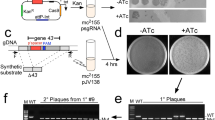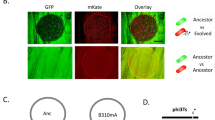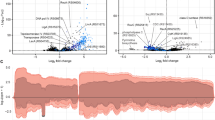Abstract
PHAGE B2h has been obtained from lysogenic complexes formed between M. phlei and phage phlei B2 (ref. 1). Phage B2h has shown in addition to host range alteration (h) changes in plating efficiency, immunity, serology, plaque and electron microscopic morphology as compared with wild phage B2 (refs. 2 and 3). It was suggested that such major changes resulting in B2h were caused by recombination between phage B2 genome and a chromosomal segment of M. phlei (F89 or SN109 respectively).
This is a preview of subscription content, access via your institution
Access options
Subscribe to this journal
Receive 51 print issues and online access
$199.00 per year
only $3.90 per issue
Buy this article
- Purchase on Springer Link
- Instant access to full article PDF
Prices may be subject to local taxes which are calculated during checkout
Similar content being viewed by others
References
Juhasz, S. E., and Bönicke, R., Nature, 210, 1185 (1966).
Juhasz, S. E., and Bönicke, R., Symposium on Mycobacterial Variation, Borstel, West Germany, October 13–15, 1965 (in the press).
Juhasz, S. E., and Bönicke, R., Canad. J. Microbiol., 11, 235 (1965).
Author information
Authors and Affiliations
Rights and permissions
About this article
Cite this article
JUHASZ, S. Reciprocal in toto Conversion of Mycobacterium phlei⇆Mycobacterium smegmatis by Mediation of an Intermediate Hybrid Genome : B2h. Nature 214, 518–520 (1967). https://doi.org/10.1038/214518a0
Published:
Issue Date:
DOI: https://doi.org/10.1038/214518a0
This article is cited by
-
Genetic transfers in mycobacteria
Folia Microbiologica (1978)
-
Transduction in Mycobacterium smegmatis
Nature (1970)
Comments
By submitting a comment you agree to abide by our Terms and Community Guidelines. If you find something abusive or that does not comply with our terms or guidelines please flag it as inappropriate.



